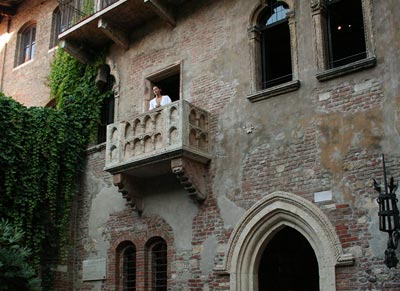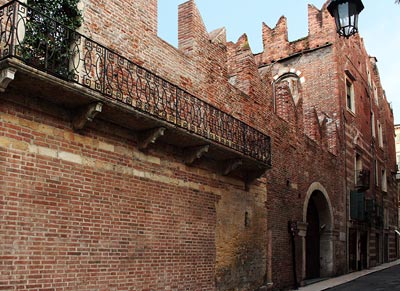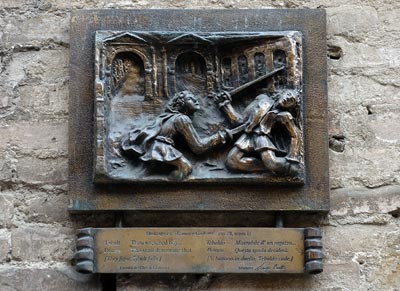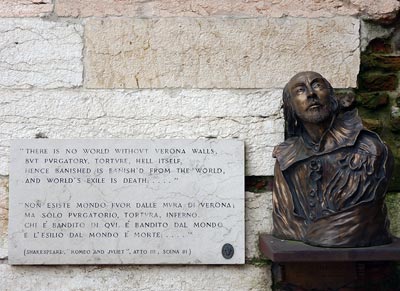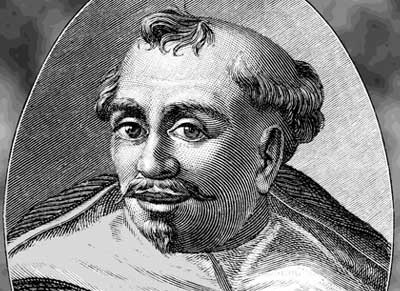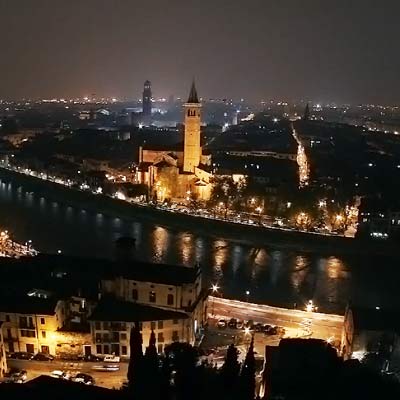Juliet's Grave

Juliet's tomb is a stone sarcophagus, empty and without a lid. It is inside the underground crypt of the church of San Francesco al Corso, an old Franciscan monastery in Verona.
The complex is now deconsecrated and houses the G.B. Cavalcaselle Museum of Frescoes.
Oncoming Tours
Info and Bookings:
+39 333 2199 645 info@veronissima.com P.I. 03616420232 C.F. CPPMHL74L13L781C
Juliet's tomb is far from the main monuments in the centre of Verona. And for a good reason as we will discover soon. Without access to the Museum of Frescoes it is not possible to see the sarcophagus. The visit to Juliet's tomb is not included in the general guided tours of Verona but only in the specific Romeo and Juliet tours.
History, Legend, Literature
The people in the street cry Romeo,
Some Juliet, and some Paris; and all run
With open outcry toward our monument.
The way in which they identified the place where the epilogue of the tragedy takes place is as compelling and exciting as a mystery novel in which you have to follow clues, intuitions, logical reasoning. The starting point is obviously the text of the story.
Romeo Exiled
Romeo kills Tybalt in a duel, and for this he is banished from Verona.
In the Middle Ages the city was protected by high walls. In the evening armed soldiers closed the gates and guarded them. In the various versions of the story, no time is wasted explaining how Romeo reached Juliet's tomb, climbing over the walls or bribing the guards. The operation is easy, quick and obvious. Evidently the plan was for Juliet to be buried outside the walls, in a place easily accessible by Romeo.
San Francesco al Corso Church

The church of San Francesco al Corso was built in 1230 on the site where, according to tradition, St. Francis of Assisi had stayed when he visited Verona in 1220. There was a Franciscan monastery next to the church. At the end of the 13th century it was the only Franciscan monastery outside the city walls. You can still see the middle age fortifications not far from the place.
Romeo would have easily accessed it without worrying about how to overcome the city's defences. Just as easily, together with Juliet, they would have left Verona if things had gone according to plan.
In Luigi da Porto's version of the story, the church of San Francesco al Corso is where Friar Laurence secretly celebrates the marriage between Romeo and Juliet.
Want to know more?
Friar Laurence Role
Friar Laurence is the religious man who secretly married the two lovers, devised the escape plan and gave the potion to Juliet. He moves with great ease within the place where the girl was buried. He enters with cumbersome burglary tools to open the sarcophagus when he realizes that Romeo will not arrive in time. His plan is to hide Juliet in his room until she is reunited with the her husband. He doesn't seem to worry about being seen sneaking around in the middle of the night with a young girl.
Friar Laurence is a Franciscan friar, like the order to which the monastery of San Francesco al Corso belongs. So he must have known the place well and knew that he could find cover and help in case of need. Perhaps that was the monastery he belonged to.
The Sarcophagus

Once they found the place, they started to search for the grave. In meantime the monastery had become a convent. There actually was a large red stone sarcophagus, empty and without any inscription.
It was a big news. Immediately began the visits of curious and passionate about history.
They increased even more in the 19th century on the wave of movements and romantic culture. Among the illustrious visitors also Lord Byron who took stone fragments from the sarcophagus as a souvenir for his lover Augusta Leigh.
It is a plain, open, and partly decayed sarcophagus, in a wild and desolate conventual garden once a cemetery now ruined to the very graves. The situation struck me as very appropriate to the legend, being blighted as their love.
Archduke John of Austria bought the lid of the sarcophagus at a high price. Marie Louise of Habsburg Lorraine, Empress of the French, had earrings and a necklace made from fragments of the red marble of which it is composed.
The Museum

At the beginning of 1900s the place was desconsacrated and abandoned in ruin. Many visitors removed pieces of the sarcophagus as souvenirs. The City of Verona decided to restore the old monastery and transformed it into a museum.
The sarcophagus of Juliet was taken to the underground crypt of the complex of San Francesco al Corso. It still rests there, among the old tombstones of monks worn out and covered in moss.
Weddings

The Municipality of Verona celebrates civil weddings in a gorgeous frescoed room inside the museum. It is a symbolic and meaningful place. It was here that the two lovers decided in an extreme gesture to remain united in death as they have been in life. According to some, this could even be the place where Friar Laurence married them in secret.
Marriages can be celebrated here not only between Veronese citizens but also foreigners from all over the world.
The Fresco Museum
Today the rooms of the ancient monastery house the museum of frescoes G.B. Cavalcaselle. Here you will find old frescoes detached from town buildings. They once decorated facades and interiors of churches and noble families' houses. Recently the museum has been restored and expanded. The collection also includes sculptures, Renaissance bronzes, Roman finds.

Verona Fresco Museum G.B. Cavalcaselle
FIND OUTVisit Juliet's Grave
There is an entrance fee to access the museum where the tomb of Juliet is. The empty sarcophagus is inside the crypt of the old monastery. With the same ticket you can also visit the frescoes exhibition although during our Romeo and Juliet tour, there is not enough time.
For any inquiry and further information on Juliet's grave and our guided tours:
Further Information:
+39 333 2199 645 info@veronissima.com P.I. 03616420232 C.F. CPPMHL74L13L781C
+39 333 2199 645
info@veronissima.com

 IT
IT 日本
日本 DE
DE FR
FR 中文
中文 ES
ES
